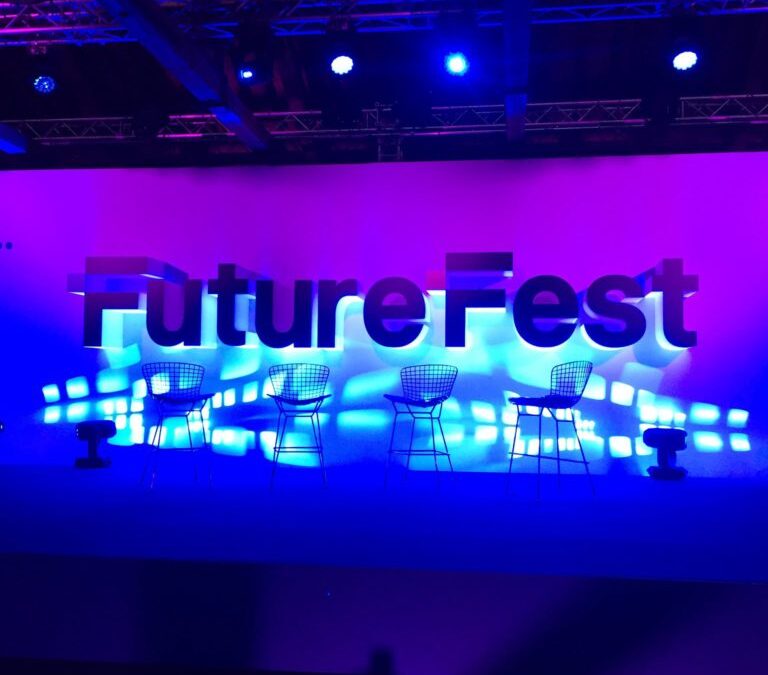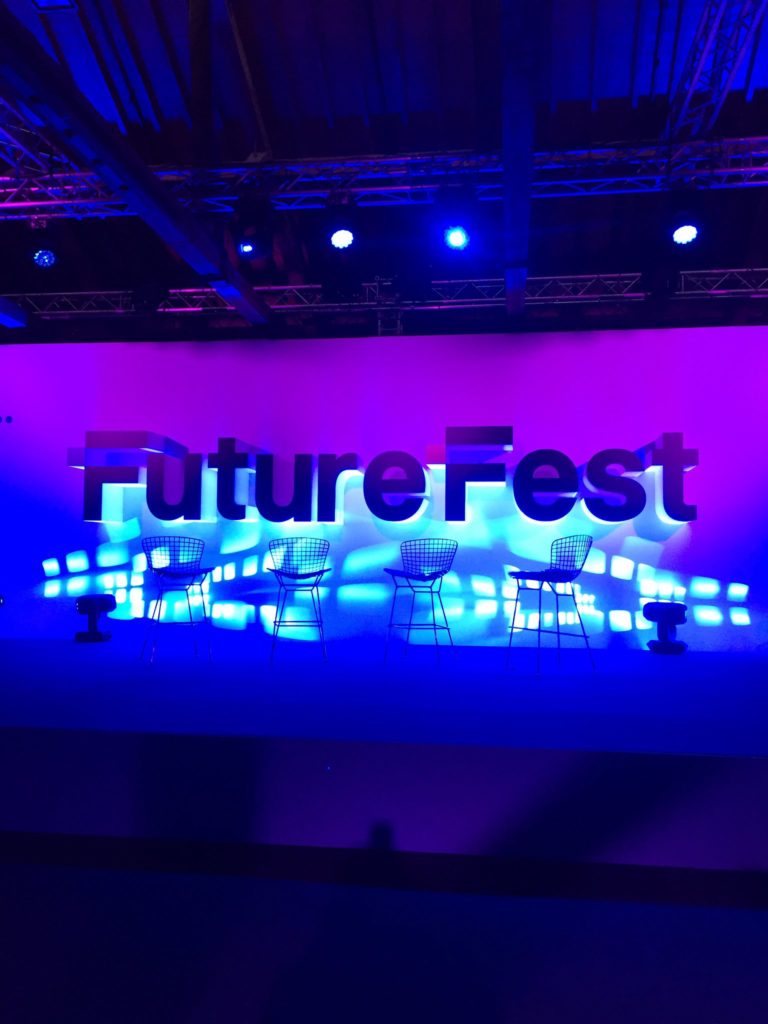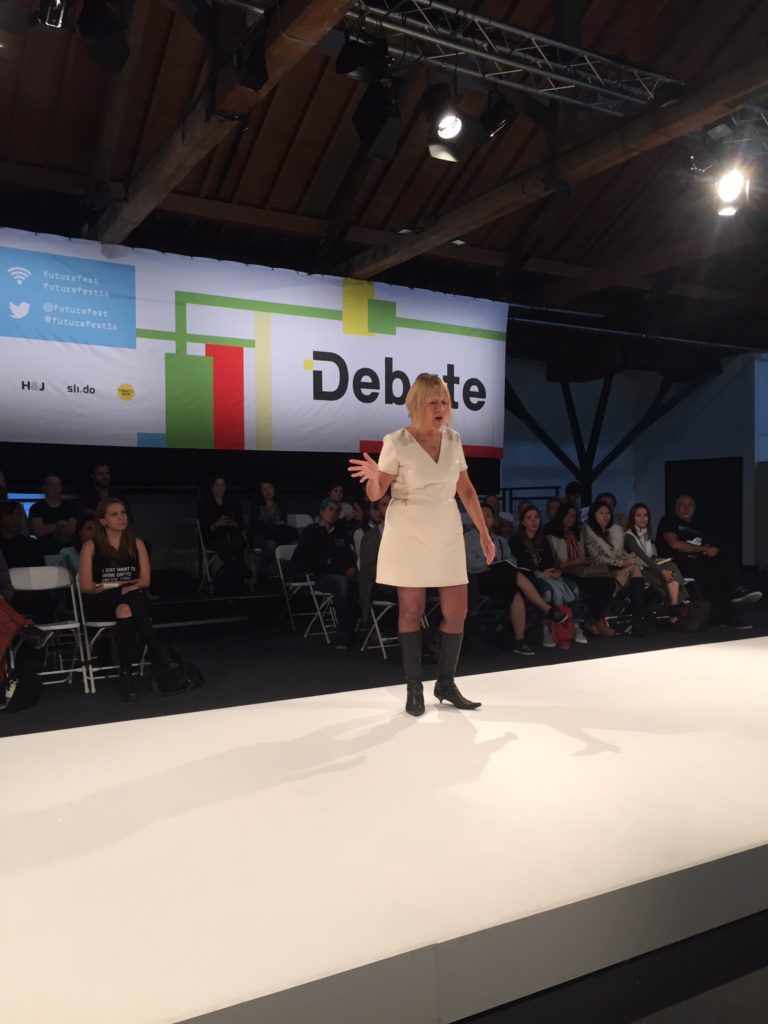In 30 years time, the very essence of who we are may shift in directions we can only imagine right now – every visceral emotion and human need from what we eat to how we express love for each other and how we interact with machines is all changing. These far-reaching ideas, and many more, which aren’t just science fiction fantasies, were demonstrated and explored over two days (September 17-18) for innovation foundation Nesta’s FutureFest 2016.
The third year of FutureFest attracted 4,000 people to Tobacco Dock in London and turned the venue into a playground of possibility. Talks from Brian Eno, DJ Spooky, Will Self, Sherry Coutu CBE, Mustafa Suleyman, Ghislaine Boddington (also a curator of Future Love happenings), Ruth Amos, Claire Lomas, Laurie Penny, Anjali Ramachandran, Kate Russell, Pat Kane (who curated the Futre Play programme), Cindy Gallop, Es Devlin, Bill Burnett, Dr. Trudy Barber, Rhyannon Styles and many, many more fascinating speakers, took place, along with a mix of digital art and performances.
What was most striking is the exploration of the absolute most basic of human existence with discussions on how we will all love, play, work and thrive taking centre stage in conversations. While big questions of politics (Caroline Lucas MP with the Green Party participated in this discussion about where things are headed politically), how we’ll use data, combat disease, consider gender identity, and more, were bantered about among the guest experts, their on-stage conversations inspired attendants to tackle monstrous ideas, and debate between themselves about the positive and negative consequences future life may bring.
Some may have found these beyond-the-now explorations a little bit creepy, such as taking a visit to the Love After Death exhibit, where 15 minute conversations with counsellors helped people chart a course for extending your presence, digitally, after you die and discussing how you want your body to be treated post-death. Also for thought exploration was a fertility exhibit about the pros and cons, and questions and concerns, of egg freezing. These topics may make some squeamish or uncomfortable, but are all good for thought provocation, and important, for thinking about future scenarios.
In fact, it is letting your brain tackle sometimes unnerving concepts that leads to amazing innovation, such as was demonstrated in the Cybathlon exhibit where examples of assistive technology and robotics showed how futuristic technology is helping people with disabilities become mobile again. Or, when cyber-athlete Claire Lomas walked onto the stage in a fully robotic exoskeleton. Bravo! This is where the future gets so exciting, and promising.

Cyber-athlete Claire Lomas walks on stage at FutureFest 2016 in exoskeleton. *Photo courtesy of FutureFest
Kicking things off at FutureFest on the Saturday morning, in the mission to push your thinking into new boundaries, was Hannes Sjoblad (a biohacking and human augmentation activist) who led a “Implant Party” on stage by having two volunteers get computer chips inserted into their hands. The chips allow them to interact with digital devices, such as finding lost keys or activating other technologies.
Among the high energy speaker presentations were appearances by Cindy Gallop (an influential woman in the advertising business and founder of IfWeRanTheWorld and MakeLoveNotPorn) who challenged work place structures and gender roles with commentary in sessions that set the room on fire, such as proclaiming “You will never own the future if you care what other people think!” and living up to her reputation of blowing things up, as “the Michael Bay of business”.
Headlining FutureFest was Brian Eno who discussed the importance of play in learning, and criticized traditional education for turning the process into something that becomes un-fun, when A-Level exams take place. Also a popular speaker was super smart DJ Spooky who offered some interesting insight into how music and technology wrap around the theme of love.
When the futuristic ideas all filled your head to overload, there were plenty of calming places to retreat to, especially the beautiful Collective Reality (an installation by body>data>space), where you could dance and move with others in a space of swirling visuals, or perch on a comfortable bean bag chair and watch professional dancers perform. Or, relax outside the venue and enjoy street food while looking at an old ship docked in the canal.
So what does 2030 hold? It is fantastic that Nesta and all the involved partners and organizers and curators provided a place to unleash what is a smorgasbord of inspiring ideas for the future. Much discussed is so far ahead from our known existence today, that it is difficult to visualize the reality, but unless we all think about it, and act toward positive, well-calibrated, outcomes –progress will never happen.
Like they say in Star Trek, FutureFest encourages us “to boldly go where no man (or woman!) has gone before.”
FutureFest 2016 was supported by innovation partner Nissan and the University of Greenwich, Oxford Martin School at the University of Oxford, D3 Technologies and EUNIC London.
The two-day event takes place every 18 months and details can be found at: futurefest.org




